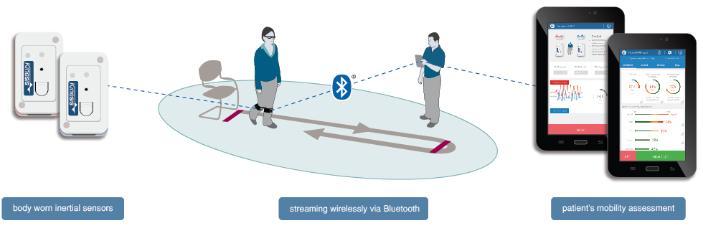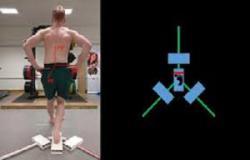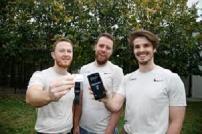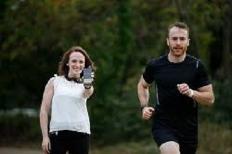PROFESSOR BRIAN CAULFIELD
UCD School of Public Health, Physiotherapy and Sports Science
UCD Insight Centre for Data Analytics
Patient-Driven Insight Facilitates Research Driven Solutions
"Understanding the human in the loop" is the key to using data to measure, understand, change or enhance human performance.
Professor Brian Caulfield is the Director of the Insight Centre for Data Analytics in UCD. His main research area is sensing and actuation. This attempts to understand data obtained from wearable sensors. Professor Caulfield explains the ethos of the Insight Centre in the video below.
Connected Health
Insight researchers work across a wide variety of application areas. These areas range from working with chronic illness, aiming to reduce falls risk or trying to increase sports performance for elite athletes. Wearable sensor technologies can be worn on the body and give researchers the capability of capturing biological data. This technology is termed ‘the sensor web'.
In the last 15 years, there has been a sensor web expansion but the researcher’s capacity to understand its value and meaning has not kept pace with the data generated.
The Insight Centre aims to address this gap.
A critical and novel feature the centre has is multidisciplinary expertise. This is achieved by bringing together disciplines such as physiotherapy, sports science, medicine, pharmaceuticals, biomedical engineering and social science. The Insight Centre also has access to individuals and groups within healthcare and organised sports sectors.
For healthcare applications, technology forms part of the ‘Connected Health’ model. This paradigm shift considers both the management of illness and the management of health through leveraging digital supports. This technology enables clinicians to learn more about how people are behaving and performing as they move through their daily lives. This allows much earlier information capture as to how people are deviating from their normal health profile.
If an individual does fall ill and needs escalation of care, they receive that care in the most appropriate place at the most appropriate time. This technology can also be used to try to encourage people to become more engaged in illness management. It is also about democratizing information.
Professor Caulfield says;
"10 years ago, the vast majority of recreational athletes had no access to any type of performance evaluation technology. Now a recreational athlete can use the sensor web to access knowledge about their performance and to avoid injury."
There are many additional projects taking place in the Insight Centre across a broad sphere.
The Q-TUG
Professor Caulfield and colleagues at Insight have collaborated with UCD start-up Kinesis Health Technologies to digitize a commonly performed clinical test called the Timed Up and Go Test (TUG).
Small sensors placed on the person capture movement data during the TUG test and Kinesis have developed a prediction model to give an individual a falls risk score. This has proved very powerful for predicting falls risk in the elderly living in the community.
The (opens in a new window)QTug has been performed on over 20,000 patients in a wide number of countries to date and is being used every day in the clinical and community settings. The Q-TUG can have a very significant impact on falls prevention. If clinicians can identify people who are at falls risk this enables them to trigger early intervention.
To date, nearly 100% of Kinesis clients are using the Q-TUG to screen those at falls risk. High-risk individuals are then connected with appropriate physical therapy programmes. The technology can then measure their response to these interventions.

The Q-YBT
Another collaboration between Insight Researcher Dr William Johnston, alongside the Irish Rugby Football Union and World Rugby, looks at the Y-Balance Test (YBT).
This test examines an individuals capability to stand on one leg and reach in three different directions. The test is scored in terms of how far a person can reach relative to their leg length whilst continuing to balance on the other leg.
The YBT can be useful for predicting athletic injury risk and documenting return from injury. Dr Johnston has now digitized the YBT (Q-YBT) by placing sensors on the body during the test.
Now the tester has the measure of how far a person reaches along with obtaining other variables around movement quality. Dr Johnston has been able to identify some specific indicators which can predict rugby players at greater concussion risk.
He has also followed this up with schools rugby players, Ulster Rugby, Ulster University and the University of Wisconsin football and ice-hockey squads. He is currently extending this project to see if the Q-YBT can predict other injuries.
Concussion is a major issue in rugby today. Dr Johnston has presented this research back to World Rugby intending to influence their concussion management policy. Early identification of those at risk can provide early rehabilitative intervention.
An independent piece of work from the UK has demonstrated that when sub-elite rugby players went through a strength and postural control re-education programme, this reduced concussion risk.
Not all players will need to go through these interventions, therefore the Q-YBT enables clinicians to identify those at risk who need early intervention.

Output Sports

Insight researchers Dr Martin O’Reilly and Dr Darragh Whelan are the researchers behind (opens in a new window)Output Sports.
They work with Strength and Conditioning Specialists and Physiotherapists, developing a scientifically driven, one-stop tool for off-field athlete performance optimisation. Their application uses wearable sensor technology to document athletes’ capabilities across a wide range of performance measures.
The app measures variables such as athlete strength along with power, speed,velocity, mobility, flexibility and balance.
This project will have a major impact on the elite sports arena and beyond. The team are currently targeting the elite level athlete as their market entry point. This technology will also have great applications in the recreational and sub-elite athletic populations and this is the area they will be examining next.
Paceman
Paceman, developed by Dr Cailbhe Doherty and Dr Alison Keogh takes data from sensors obtained from an individuals running performance. It combines this data with global historical data obtained from other peoples’ race performances. Essentially it uses this data to build models that will enable recreational runners to be more effective in race preparation and performance.
For a given race profile, the application can give a person a mile by mile race pacing strategy designed to give them a specific finishing time. He explains:
"If a person wants to do a marathon in four hours, they will be able to take a look at the unique race profile for that particular course. They will be given real-time feedback as they do the race to help them stay on strategy. If they are going off strategy the application will recalculate and reset the remainder of the race strategy."
This application is available on the IOS platform for Strava and the team are shortly launching it on the Garmin platform. The application can also give a personalised race training plan which can fit in with some constraints the user designs.

MultiPath Stimulation Technology
Insight have also been collaborating with Atlantic Therapeutics over a number of years, to develop a novel electrical stimulation technology called MultiPath Stimulation Technology. Instead of just having pairs of electrodes over target muscles, the clinicians use arrays of electrodes around a particular region of interest in the body.
The team have developed a MultiPath stimulation protocol that was very effective at targeting the pelvic floor muscles with surface electrodes. That project has resulted in a product in the marketplace ‘Innovo’ which is aimed at treating urinary stress incontinence. Innovo has been used in over 500,000 patients to date.
The team has also been working on the application of MultiPath technology to assisting in cancer rehabilitation.
Insight Ph.D. student Mr Dominic O’Connor is working on adapting the technology for aerobic stimulation and implemented this in patients that are undergoing cancer rehabilitation. Some encouraging preliminary results suggest that electrical stimulation can be a viable cancer rehabilitation technology.
Prof Caulfield says that the method of electrode application enables clinicians to be much more efficient about targeting specific neural tissues and in some cases allows deep neural tissues to be targeted as opposed to superficial.
He comments;
"One of the big challenges in cancer rehabilitation is that when a patient is through the very aggressive oncology treatments, they are often left with very severe debilitating loss of muscle, very profound fatigue, and psychological issues. It is very difficult for the patient to start physical rehabilitation if they are deconditioned. Neuromuscular electrical stimulation can bridge that very deconditioned state to enable an individual to be more proactive and more engaged in traditional forms of rehabilitation."
Another Insight PhD student Mr Robert Argent has a collaboration with the Beacon Hospital.
They are examining how clinicians can deliver sensor-driven interactive feedback during rehabilitation exercises. A lot of technical solutions for this have been brought into the market in recent years but they are not gaining traction in a clinical setting.
Professor Caulfield thinks that one of the reasons for this is these sensors tend to be developed by technical people and not clinicians.
Mr Argent is working with patients and computer scientists to address this. They are aiming to try and design this technology for rehabilitation exercise in the areas of total knee and total hip replacement.
Machine learning models can be used to take data from wearable sensors when a person is performing an exercise. They can tell an individual whether or not they are doing the exercises the correct way giving the patient the type of verbal feedback they would get from a clinician.
This is done through a sensor placed on the leg which sends the data to an application which is giving the person the feedback.
User-Centred Design
Other researchers at Insight include Ethnographer and PhD candidate Mr Patrick Slevin, Physiotherapist and PhD candidate Ms Ciara Duignan, Rehabilitation Doctor Dr Estefania Guiseido-Fernandez and Physiotherapist Ms Rachelle Connelly.
A common thread of their four projects is an evaluation of peoples’ perceptions around using digital devices to monitor health or illness. These projects demonstrate the interdisciplinary nature of research at Insight and the idea that digital technologies have to effectively interact with people and their lives.
"Qualitative research understands the human in the loop and is critical to design appropriate technological solutions."
Professor Brian Caulfield, Insight Centre for Data Analytics, UCD
About the researcher
Professor Brian Caulfield, UCD School of Public Health, Physiotherapy and Sports Science is also the Director of the Insight Centre for Data Analytics in the O’Brien Centre for Science in University College Dublin. Insight is Irelands National Centre for Data Analytics and is funded by Science Foundation Ireland.
Professor Caulfield believes researchers need to do what is termed ‘qualitative ethnographic research’ to design appropriate technological solutions. Meaning the design of technology should be user-centred and the drive for solutions needs to originate from the individuals who need the technology. Researchers achieve this by working with patients to design the technology that best suits their needs.
Insight also works with the pharmaceutical industry around understanding how sensors can capture change in patient performance as a result of therapeutic intervention. In the future, this can have a significant impact on how clinical trials are conducted.
Key Research Interests
Wearable Sensing and Actuation
User-Centred Design
Physiotherapy and Rehabilitation
Sports Performance
(opens in a new window)Brian Caulfield on X
Associated References
(opens in a new window)Insight Centre
(opens in a new window)Irish Times - Paceman and Output Sports
(opens in a new window)Kinesis Health
(opens in a new window)The 42_Johnston-Concussion
(opens in a new window)Paceman on X
(opens in a new window)Run Ireland - Paceman
Associated academic papers
Johnston, W., O’ Reilly, M., Duignan, C., Liston, M., McLoughlin, R., Coughlan, G.F. and Caulfield, B., 2019. (opens in a new window)Association of Dynamic Balance With Sports-Related Concussion: A Prospective Cohort Study. The American Journal of Sports Medicine, 47 (1), pp.197-205.
Doherty, C., Keogh, A., Davenport, J., Lawlor, A., Smyth, B. and Caulfield, B., 2019. (opens in a new window)An evaluation of the training determinants of marathon performance: A meta-analysis with meta-regression. Journal of Science and Medicine in Sport.
Keogh, A., Smyth, B., Caulfield, B., Lawlor, A., Berndsen, J. and Doherty, C., 2019. (opens in a new window)Prediction Equations for Marathon Performance: A Systematic Review. International Journal of Sports Physiology and Performance, 14(9), pp.1159-1169.
Whelan, D., Delahunt, E., O'Reilly, M., Hernandez, B. and Caulfield, B., 2019. (opens in a new window)Determining Interrater and Intrarater Levels of Agreement in Students and Clinicians When Visually Evaluating Movement Proficiency During Screening Assessments. Physical Therapy, 99(4), pp.478-486.